Artificial intelligence is reshaping how individuals and businesses generate income in 2025. With the AI market expected to grow from $244.22 billion today to $1.01 trillion by 2031, tools like AI Apps, ChatGPT Enterprise, and Shopify Magic are helping users automate tasks, create content, and optimize operations. These tools are already delivering measurable results, from increasing revenue by 10-30% to saving businesses millions in operational costs.
Here’s a quick overview of tools covered in the article:
- AI Apps: A directory of 1,000+ AI tools for content creation, marketing, and e-commerce.
- ChatGPT Enterprise: Advanced AI for business productivity and custom applications.
- Jasper AI: A platform for generating branded content at scale.
- Copy.ai: AI for writing marketing and sales content.
- MidJourney: AI-powered digital art generation.
- Runway ML: Tools for video editing and AI-driven video creation.
- Shopify Magic: AI tools for e-commerce merchants.
- Synthesia: AI avatars for video content production.
- Zapier AI: Workflow automation across thousands of apps.
- Tableau AI: AI analytics for data-driven decision-making.
These tools cater to freelancers, small businesses, and enterprises, offering opportunities to save time, reduce costs, and increase revenue. Whether you’re looking to streamline operations, create digital products, or boost marketing efforts, AI tools in 2025 provide clear paths to financial growth.
I Tested 100+ AI Tools, These 6 Will you make money
1. AI Apps
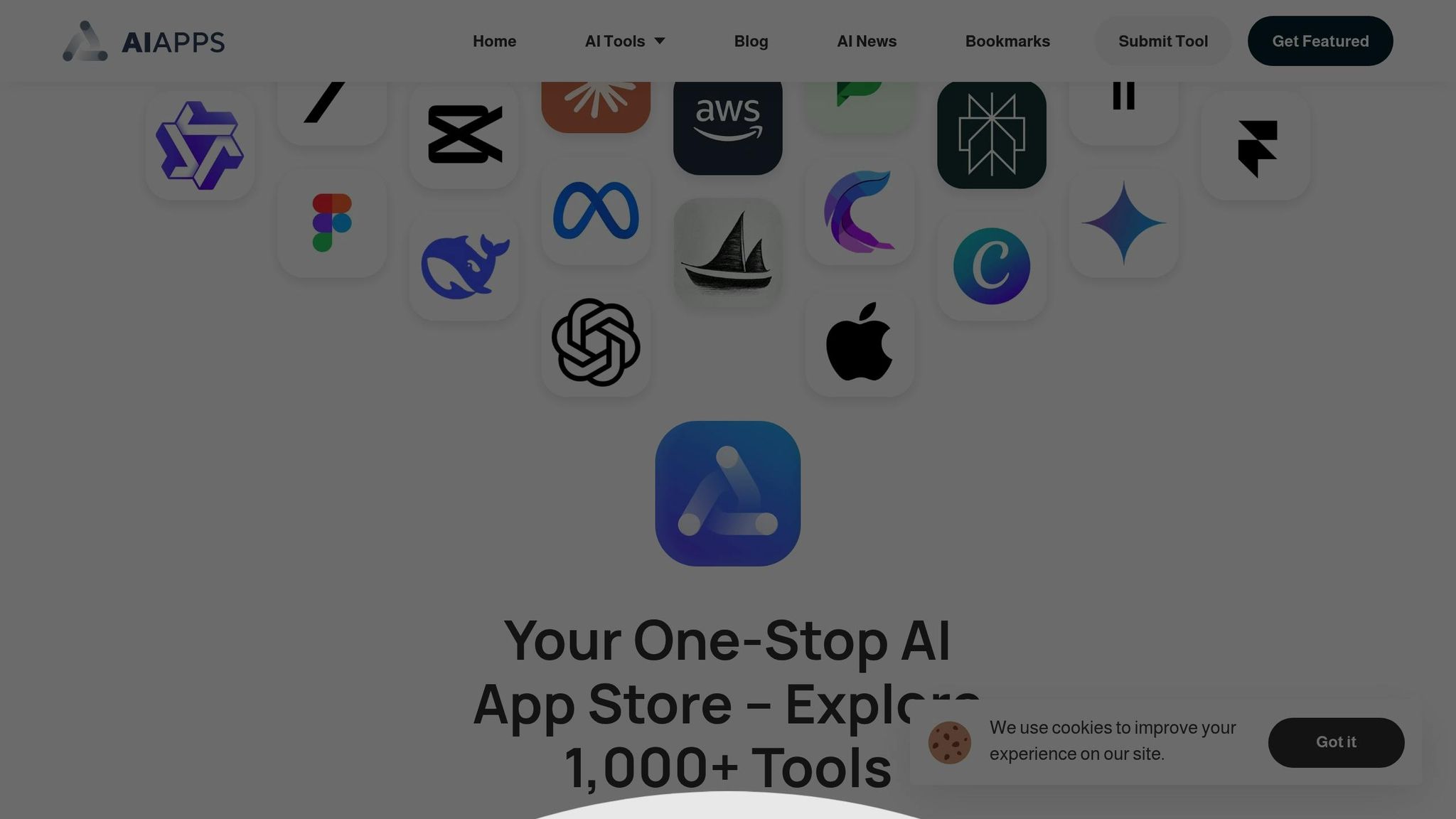
AI Apps brings together over 1,000 AI tools in one place, making it easy for users to find and implement solutions that help increase revenue. Instead of wasting time searching across different sites, users can browse a comprehensive directory that includes everything from AI art generators to automation tools.
Key Features and Capabilities
The platform offers an advanced filtering system that allows users to sort tools by category, sub-category, and pricing model. This makes it simple to find free tools for testing or premium options that fit specific budgets. Categories covered include AI text generators, video editing tools, image creation software, and automation platforms.
To ensure quality, AI Apps employs a multi-step verification process and regularly updates its directory with new and trending tools. Developers can also submit their products, ensuring the platform stays current and offers fresh monetization opportunities.
Monetization Potential
AI Apps unlocks various ways for users to generate revenue:
- Content creators can use AI art generators and video tools to produce professional-grade materials more efficiently, enabling them to handle more projects or launch digital products.
- Marketing professionals benefit from AI-powered email marketing and predictive analytics tools, which can improve conversion rates by up to 50%.
- E-commerce entrepreneurs can leverage AI chatbots for automated customer support and pricing optimization tools that increase sales by 10-30%.
- Service providers can streamline operations using workflow automation tools, allowing them to manage more clients and boost income.
With the global AI market projected to hit $1.8 trillion by 2030, and AI-generated content expected to make up 90% of online material by 2026, a centralized directory like AI Apps is becoming an essential resource for those looking to monetize AI.
Pricing (in USD)
AI Apps uses a freemium model to accommodate a range of users. The Free Listing option provides basic access to the directory, making it ideal for beginners or small businesses experimenting with AI tools.
For developers and companies aiming for greater visibility, there are Featured Listing options available as paid promotions. These offer perks like homepage placement, top spots in relevant categories, and enhanced visual presentation.
The AI tools listed on the platform vary in cost, from free options to enterprise-level solutions. Basic implementations typically range from $20,000 to $80,000, while more advanced, custom solutions can cost between $100,000 and $500,000+. Many tools also offer subscription-based pricing, making them accessible to smaller businesses.
Industry Use Cases
AI Apps caters to a wide range of industries, offering tools that drive efficiency and innovation:
- Financial services professionals can use AI-driven trading bots and fraud detection systems, with the fintech AI market expected to grow to $22.6 billion by 2025.
- Healthcare practitioners can adopt AI-assisted medical imaging tools, which reduce diagnostic errors by 30-40%, improving patient care and consulting opportunities.
- Education entrepreneurs can explore AI-powered language learning tools and tutoring platforms, which enhance retention rates by 30%.
- Project managers and consultants can utilize AI workflow tools to speed up project completion by 20-30%.
Whether you're looking to automate tasks, create digital products, or improve services, AI Apps provides a curated selection of tools designed to help you achieve faster results and maximize revenue. Up next, we’ll dive into ChatGPT Enterprise and its role in driving business growth.
2. ChatGPT Enterprise
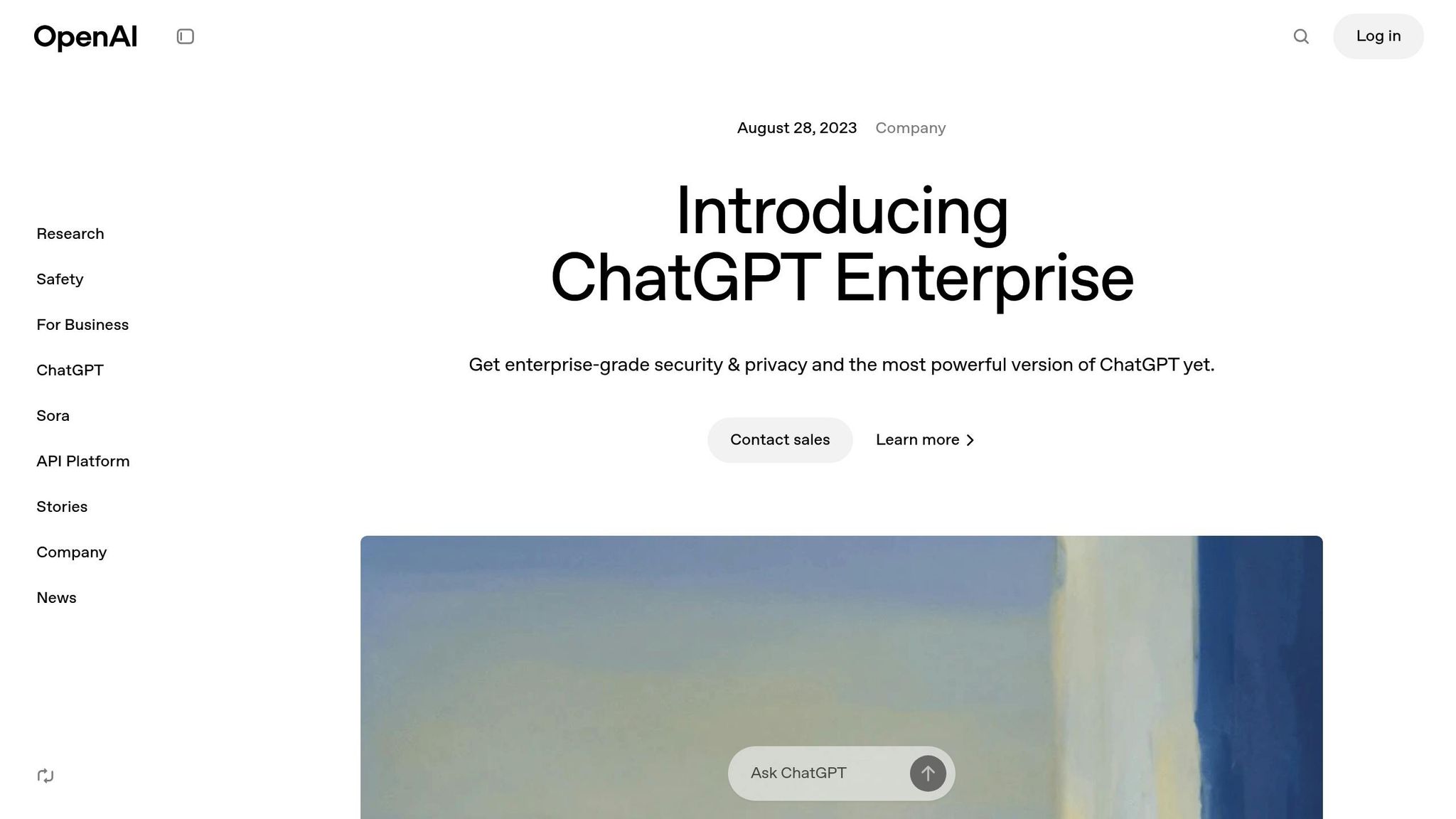
ChatGPT Enterprise is OpenAI's advanced platform designed specifically for businesses looking to improve efficiency and boost revenue. Unlike the consumer version, this enterprise-grade tool offers unlimited usage, twice the speed, and unrestricted access to the GPT-4 and GPT-4o models. Let’s dive into how its features and capabilities make it a game-changer for productivity and profitability.
Key Features and Capabilities
One of the standout features of ChatGPT Enterprise is its 32k context window, which allows it to process inputs up to four times longer than the standard version. This makes it ideal for analyzing lengthy documents, tackling complex datasets, or reviewing detailed business reports - all in a single session.
The platform integrates effortlessly into existing company workflows. It provides free API tokens and a new agent mode, enabling businesses to develop custom applications and automate tasks that previously required manual effort - all without additional costs.
Security is another priority. The platform meets enterprise-grade standards, ensuring that organizations can safely train the AI on proprietary data while adhering to strict data protection protocols. Additionally, the Canvas feature supports collaborative drafting and editing, making it a valuable tool for team projects.
Monetization Potential
ChatGPT Enterprise doesn't just improve operations - it opens doors to new revenue streams. With 80% of Fortune 500 companies already using ChatGPT, the platform has proven its value in the business world. For instance, by cutting down research time by an average of one hour per day, it directly contributes to higher productivity and profitability.
"ChatGPT Enterprise has cut down research time by an average of an hour per day, increasing productivity for people on our team. It's been a powerful tool that has accelerated testing hypotheses and improving our internal systems."
- Jorge Zuniga, Head of Data Systems and Integrations at Asana
Businesses can monetize the platform by creating custom AI agents tailored to specific needs like customer service, sales, or technical support. OpenAI also offers the CustomGPT.ai affiliate program, which provides up to 20% commissions on referrals. Additionally, companies can generate revenue through AI-powered consulting services, automated workflows, and content creation, using subscription or outcome-based pricing models.
Pricing (in USD)
ChatGPT Enterprise operates on a customized pricing structure, starting at around $60 per user per month, with a minimum commitment of 150 users and a 12-month contract. For example:
- 150 users: Approximately $9,000 per month
- 2,000 users: Scales to roughly $120,000 per month
Self-serve pricing isn’t available; companies must contact OpenAI's sales team for tailored quotes based on their specific needs. The premium pricing is justified by top-tier support and dedicated account management provided to enterprise clients.
Industry Use Cases
ChatGPT Enterprise is making waves across industries. In e-commerce, businesses use it for personalized product recommendations and automated customer support. Sebastian Siemiatkowski, CEO of Klarna, shares:
"At Klarna, we are constantly seeking innovative solutions to strengthen our employees' abilities and enable them to best serve our 150 million active users across the globe. With the integration of ChatGPT Enterprise, we're aimed at achieving a new level of employee empowerment, enhancing both our team's performance and the customer experience."
- Sebastian Siemiatkowski, CEO at Klarna
Creative industries are also reaping the benefits. Danny Wu from Canva highlights:
"From engineers troubleshooting bugs, to data analysts clustering free-form data, to finance analysts writing tricky spreadsheet formulas - the use cases for ChatGPT Enterprise are plenty. It's become a true enabler of productivity, with the dependable security and data privacy controls we need."
- Danny Wu, Head of AI Products at Canva
Beyond these examples, companies are automating repetitive tasks and generating regular metrics reports, streamlining their workflows and freeing up valuable time.
3. Jasper AI
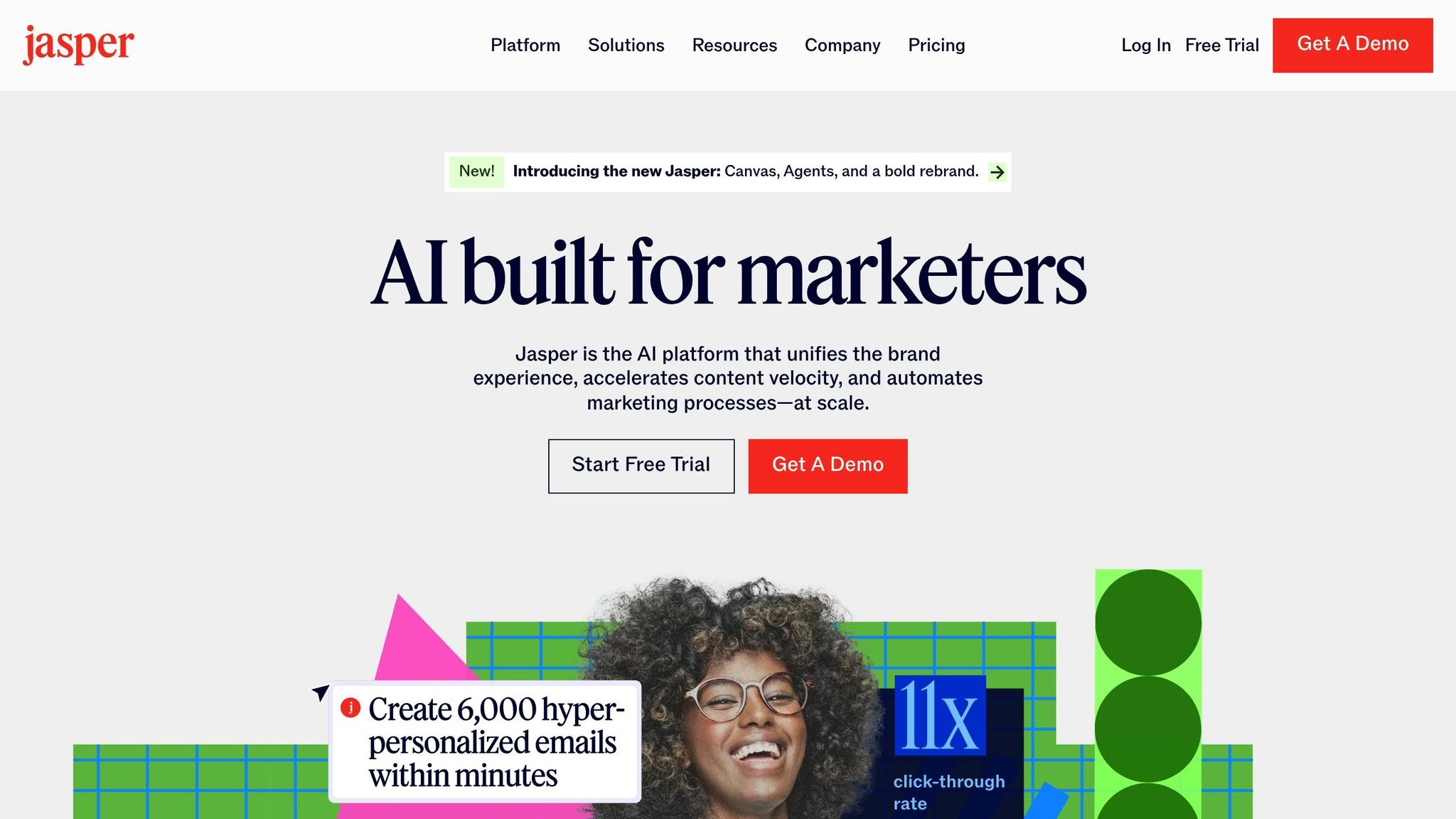
Jasper AI is making waves as a go-to platform for producing on-brand content at scale. With more than 52.6% of professionals now incorporating generative AI tools into their workflows, Jasper has emerged as a top choice for content creators aiming to monetize their efforts. Its projected revenue of $88 million underscores its growing influence in the AI content industry.
Key Features and Capabilities
Jasper AI stands out by helping users maintain brand consistency while speeding up content production. Its Brand Voice feature lets users train the AI to replicate their unique tone and style, ensuring all content aligns with their brand identity across platforms. The platform offers over 50 templates tailored for various content needs, including blog posts, website copy, social media ads, and email campaigns.
For real-time brainstorming, Jasper Chat provides interactive writing assistance, while SEO Mode, integrated with Surfer SEO, optimizes content during the writing process. The Jasper Canvas workspace supports collaborative marketing campaign creation, and Jasper Agents handle routine tasks with built-in brand context through Jasper IQ.
Visual content is also covered with the AI Image Suite, which generates brand-consistent images at scale. Additional features include support for over 30 languages, team collaboration tools with approval workflows, a plagiarism checker, and Recipes - pre-built workflows designed to speed up content creation. These tools allow users to maximize their content's potential and profitability.
Monetization Potential
Jasper AI opens doors to several revenue opportunities across different business models. Freelancers, for instance, can use Jasper to offer services on platforms like Fiverr and Upwork, where ad copy projects can fetch anywhere from $40 to $600, depending on the complexity. Another avenue is drop servicing, where users manage content creation for multiple clients using a single Jasper subscription.
Success stories highlight the platform's earning potential. Sarah, a former barista, now earns $4,300 monthly writing product descriptions with Jasper AI. Mike managed to build a six-figure affiliate site in just six months without writing a single post himself. Another example is a "Keto Air Fryer Cookbook", entirely written with Jasper, which earns $1,700 per month on Amazon KDP. Local SEO services are also lucrative; Jake, for instance, charges $1,200 per client per month and earns $3,600 while working just six hours weekly with three clients.
Pricing (in USD)
Jasper AI offers three pricing plans to suit different needs:
- Creator Plan: $49 per month per seat ($39 per month if billed annually)
- Pro Plan: $69 per month per seat ($59 per month if billed annually)
- Business Plan: Custom pricing with a 12-month commitment
The Creator plan is ideal for individuals, offering single-brand voice access and SEO Mode. The Pro plan caters to small marketing teams, providing additional seats, multiple brand voices, 10 knowledge assets, Jasper Art access, and three instant campaigns. Opting for annual billing cuts costs by about 20%, and non-profits receive a further 20% discount. Both the Creator and Pro plans include a 7-day free trial.
Industry Use Cases
Jasper AI is transforming content creation across various industries by streamlining workflows and improving marketing efficiency. As Elaina Shekhter, Chief Marketing & Strategy Officer, explains:
"Our marketing teams have cracked the code of using Jasper as an agentic partner in our day-to-day lives, transforming how we work, collaborate and evolve as an organization."
E-commerce businesses rely on Jasper for crafting product descriptions, category pages, and promotional content. Content agencies use the platform to scale their output while maintaining quality for multiple clients. SaaS companies benefit from Jasper's ability to generate landing pages, email campaigns, and blog posts designed to drive conversions. Bryan Olshock, Chief Marketing Officer, notes:
"Jasper has the potential to fundamentally transform the way marketing teams operate by boosting efficiency, accelerating execution, and delivering high-quality campaigns faster."
Affiliate marketers and digital publishers also capitalize on Jasper's ability to produce SEO-optimized content at scale. With email marketing delivering a 42% ROI for every $1 spent, Jasper-generated email campaigns can significantly boost revenue. With a G2 score of 4.7 out of 5 stars from 1,242 reviews, Jasper AI has proven its value across these diverse applications.
4. Copy.ai
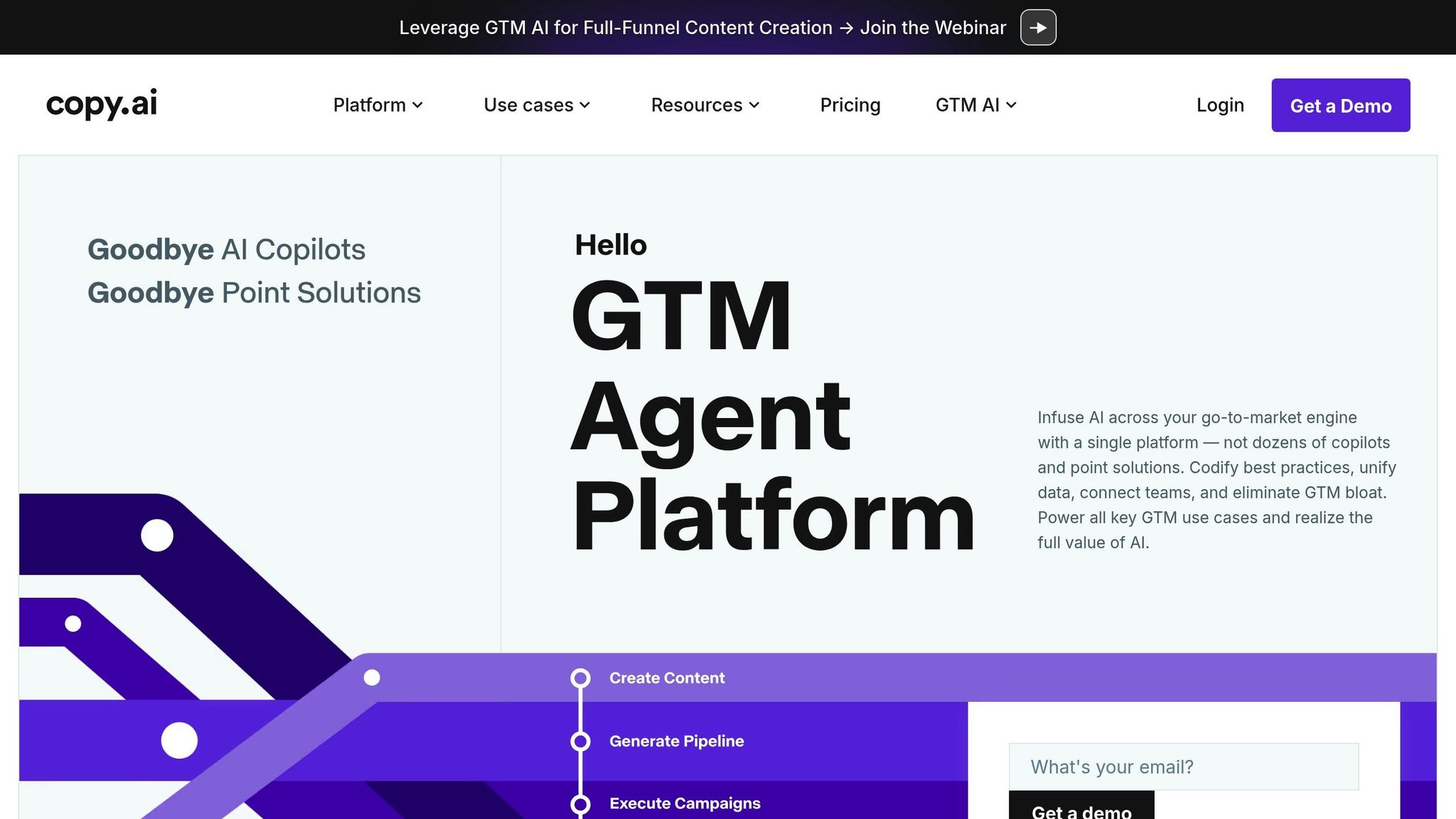
Copy.ai is a powerful AI-driven platform designed to streamline marketing and sales workflows. With 58% of marketers using generative AI reporting improved content performance and 54% noting cost reductions, this tool is positioned as a game-changer for businesses aiming to boost revenue in 2025.
Key Features and Capabilities
Copy.ai uses advanced language models like GPT-4 to craft engaging, on-brand content across various formats. Its pre-built, customizable workflows don’t require technical expertise, making it accessible to businesses of all sizes.
The platform simplifies time-consuming tasks in areas like content creation, demand generation, sales operations, and enablement. It can research, draft, repurpose, and personalize content at scale. Each step in the workflow can be tailored with precise instructions, ensuring the output aligns perfectly with brand guidelines.
Integration is another strong point. Copy.ai connects with over 2,000 apps, creating a seamless link between marketing and sales operations. It supports multiple AI models, offering flexibility for diverse use cases, and even allows workflows to be embedded directly into websites for smoother content creation. Its user satisfaction is reflected in its 4.7 G2 rating.
These features not only save time but also create opportunities for significant revenue growth.
Monetization Potential
Copy.ai’s automation capabilities unlock multiple revenue streams. Sales teams using the platform report a 50% increase in leads and appointments, while AI-powered lead scoring has been shown to improve conversion rates by up to 51%.
The efficiency gains from using Copy.ai translate into tangible cost savings and revenue increases. For instance, AI tools can boost marketer productivity by 10%, contributing to potential annual savings of $463 billion across industries. Additionally, personalized outreach efforts can improve response rates by up to 14%.
Real-world examples highlight the financial impact of Copy.ai. Roman Olney, Head of Global Digital Experience at Lenovo, shared:
"Copy.ai has been phenomenal in transforming the way we develop marketing content. By automating workflows that would typically take weeks and cost thousands of dollars through agencies, they've saved us $16 million dollars this year alone."
Jean English, Chief Marketing Officer at Juniper Networks, also praised the platform:
"Thanks to Copy.ai, we're generating 5x more meetings with our personalized, AI-powered GTM strategy."
Companies with well-optimized prospecting processes see 50% more sales-ready leads at 33% lower costs, and businesses incorporating AI into their sales strategies have experienced up to a 30% increase in lead conversion rates.
Pricing (in USD)
While specific pricing tiers for Copy.ai aren’t listed, the platform’s return on investment is clear. For example, Lenovo reported $16 million in annual savings using Copy.ai, demonstrating its value for enterprise clients.
Industry Use Cases
Copy.ai caters to a variety of industries, offering tailored solutions that directly impact revenue. In sales, it analyzes customer data, predicts buying behavior, and fine-tunes pricing strategies. Marketing teams use it to personalize customer experiences, enhance campaigns, and improve lead generation. Meanwhile, customer success departments rely on it to predict churn, identify upsell opportunities, and optimize retention efforts.
For high-ticket affiliate marketers, Copy.ai simplifies content creation by generating high-quality, engaging material quickly. Sales and marketing teams benefit from unified account lists and personalized drip campaigns, often seeing up to 20% annual growth and 75% of email revenue from automated sequences. Additionally, 64% of B2B companies report improved efficiency through marketing automation, with Copy.ai serving as a key enabler of these results.
With its robust capabilities, Copy.ai exemplifies how AI-powered tools can drive measurable financial growth in today’s competitive landscape.
5. MidJourney
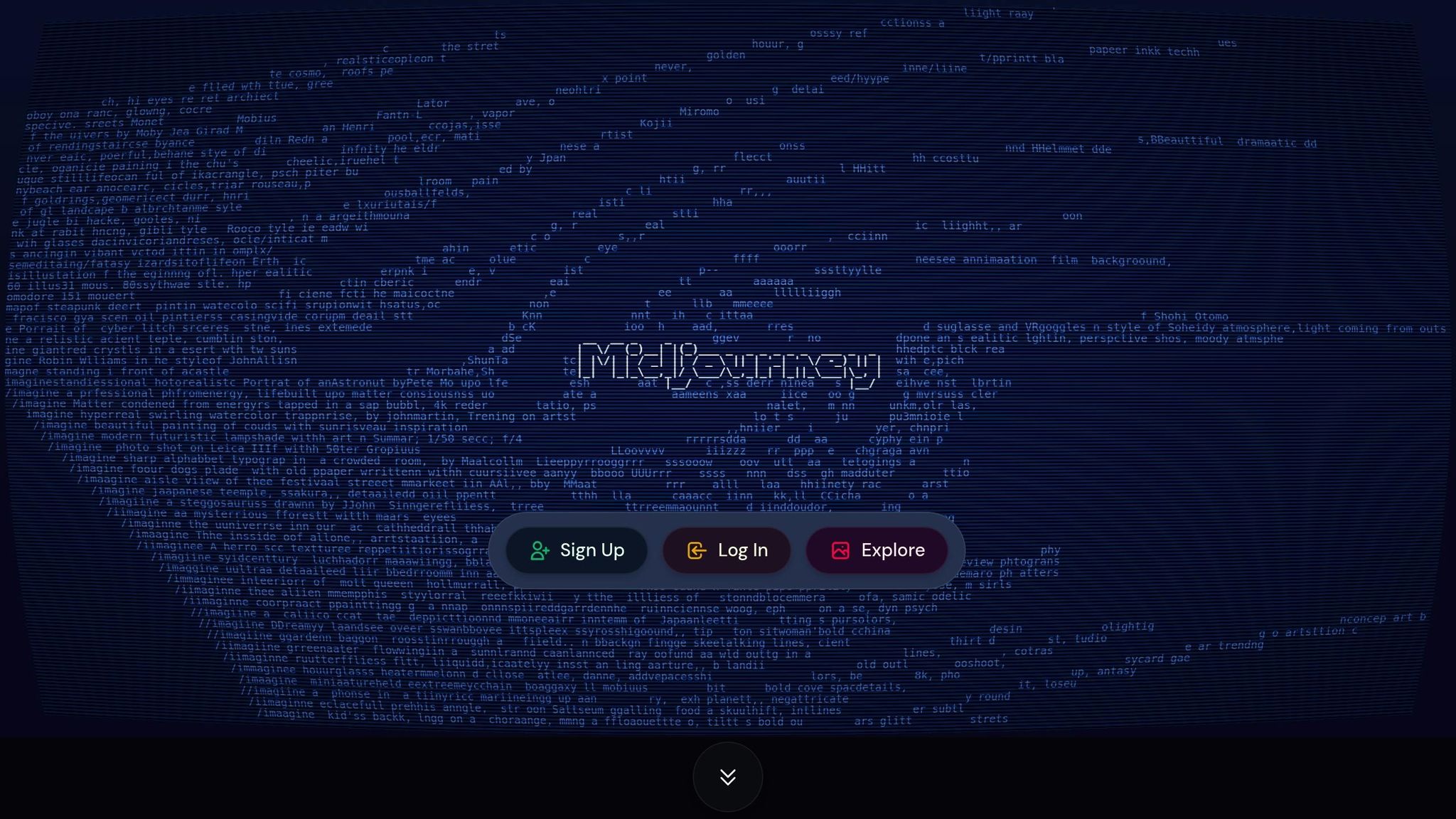
MidJourney is a powerful tool that transforms text prompts into high-resolution digital artwork. With nearly half (47%) of individuals aged 18–34 recognizing AI-generated visuals as legitimate art, this Discord-based platform has carved out a significant space in the creative world. Its capabilities have opened up exciting earning opportunities for artists, designers, and entrepreneurs.
Key Features and Capabilities
MidJourney's text-to-image generator creates professional-quality visuals with resolutions up to 1,792 x 1,024 pixels. It offers three operational modes - Fast, Relax, and Turbo - that let users manage GPU usage based on their needs.
The platform goes beyond simple image generation, allowing users to upscale images, create variations, and make precise adjustments using tools like the "Vary (Region)" feature, which provides fine control over specific parts of an image. It also supports style and character references, enabling users to apply artistic styles from reference images and maintain consistent character designs across multiple creations. Whether it's vaporwave or hyperrealism, MidJourney can replicate a wide range of artistic styles, offering creators endless possibilities.
MidJourney integrates seamlessly with Discord and web-based tools, providing a collaborative environment for image editing and variation. This makes it suitable for both personal projects and professional applications, no matter the size of the business.
Monetization Potential
MidJourney offers a range of ways to earn income across various markets. For instance, the NFT market, which peaked at $11.16 billion in sales, provides a lucrative space for AI-generated digital art. Stock photography is another avenue, with platforms like Adobe Stock offering 33% royalties for accepted images.
Freelancers can also capitalize on MidJourney. Projects on platforms like Upwork start at $10 per hour and can exceed $390 for specialized services. Print-on-demand products offer another consistent revenue stream, with items like mugs, phone cases, and posters selling for $19–$33 each. Additionally, creating educational content, such as MidJourney tutorials on Udemy, can generate income, with courses priced between $49.99 and $79.99.
Real-life success stories highlight the platform's potential. For example, Emily began selling AI-generated fantasy landscape prints on Etsy in March 2024, which quickly grew into a thriving online store. John, a graphic designer, built a diverse portfolio of unique logo designs, attracting businesses looking for standout branding solutions. Alice launched a YouTube channel offering MidJourney tutorials, gaining a large subscriber base and monetizing through ads and sponsorships. Lucy, based in Manchester, turned her surreal AI-generated landscapes into NFTs, successfully selling them on platforms like OpenSea and Rarible.
Pricing (in USD)
MidJourney offers four subscription tiers to suit different usage levels:
- Basic Plan: $10/month ($96/year) for 3.3 hours of Fast GPU time.
- Standard Plan: $30/month ($288/year) with 15 hours of Fast GPU time and unlimited Relax GPU time.
- Pro Plan: $60/month ($576/year) for 30 hours of Fast GPU time, unlimited Relax GPU time, and Stealth Mode for private projects.
- Mega Plan: $120/month ($1,152/year) with 60 hours of Fast GPU time and all Pro features included.
Annual plans offer a 20% discount for all tiers. Additional GPU time can be purchased for $4/hour, and Turbo mode costs double the standard rate.
Industry Use Cases
MidJourney's versatility makes it a valuable tool across multiple industries. For marketers, it can produce custom visuals for campaigns, social media, and presentations. Small business owners can use it to design professional-quality graphics for websites, products, and promotional materials without breaking the bank.
Game developers and storytellers rely on MidJourney to visualize characters, environments, and concepts during early development stages. UI/UX designers use it to create mockups and visual elements that enhance digital interfaces.
The platform also benefits visual content creators by accelerating the ideation process and offering diverse creative options. Graphic designers use it for concept art, unique backgrounds, and visual assets, while bloggers and social media influencers generate eye-catching visuals for their platforms.
Specialized uses include creating personalized avatars, pet portraits, and coloring book illustrations. It’s also a go-to tool for designing logos - whether minimalist, emblematic, or flat icons - and for producing wall art by specifying the subject, style, and medium. This broad range of applications highlights MidJourney's growing role in the world of AI-driven creativity and income generation.
6. Runway ML
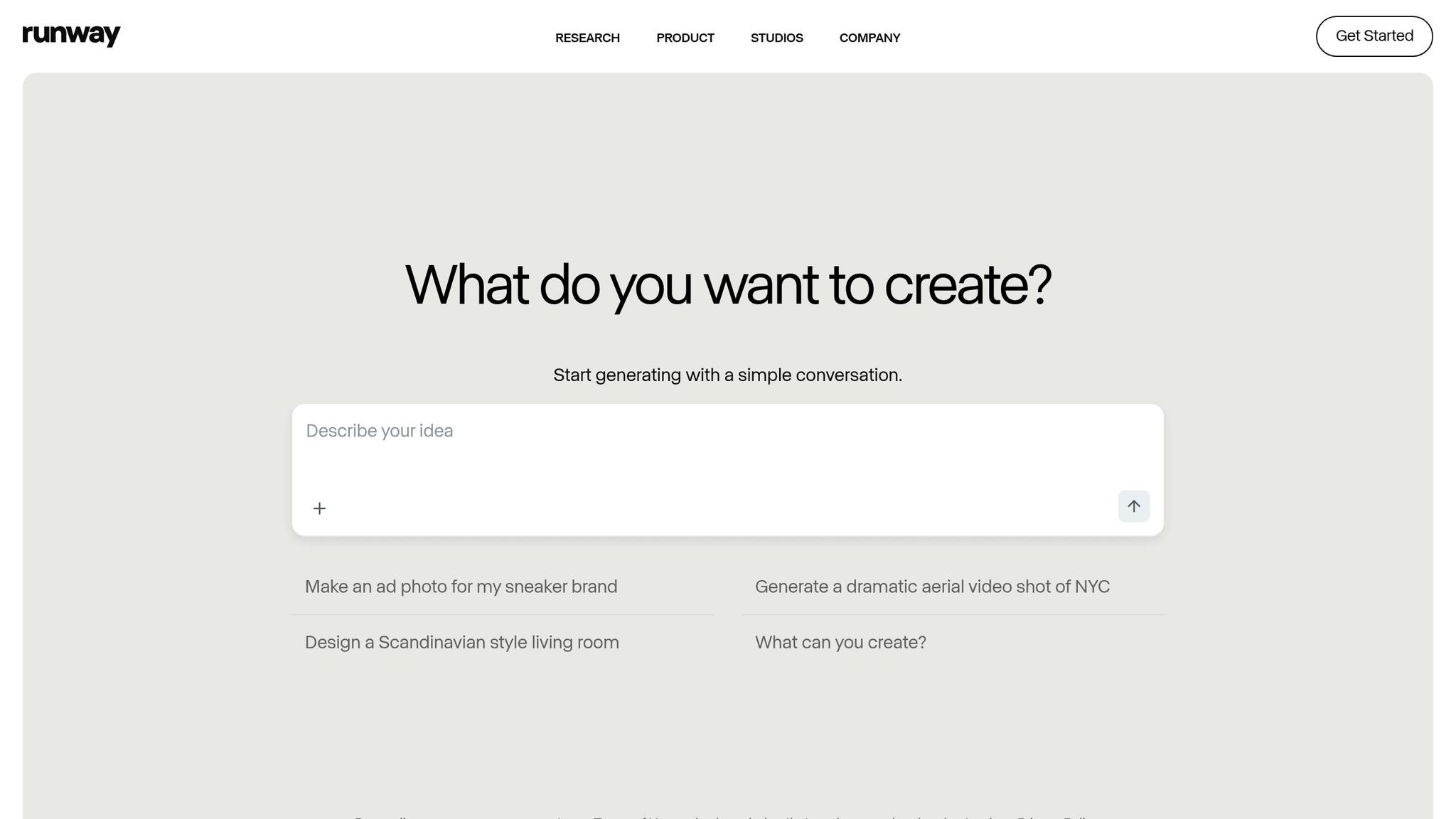
Runway ML is making waves in AI-powered video creation, offering tools that bring professional-quality videos within reach for creators and businesses alike. With its Gen-4 model, this cloud-based platform has earned a solid 4.2/5-star rating from users worldwide. It’s not just a tool; it’s a resource for creators looking to streamline production and unlock new opportunities.
Key Features and Capabilities
Runway ML’s Gen-4 model is a powerhouse, turning text or images into polished videos and transforming existing footage with artistic video-to-video edits. Its editing suite includes features like scene detection, real-time edits, and special effects, making it a favorite for creators.
The Gen-4 model brings some standout tools to the table. Character Consistency ensures characters remain uniform across scenes, enhancing storytelling. Coherent Environments keep digital settings stable throughout a video, while Perspective Control allows creators to regenerate elements from different angles, opening up creative possibilities.
Other tools include:
- Motion Brush for precise movement adjustments.
- Visual References to blend images with text instructions for more accurate results.
- 4K Upscaling to enhance video resolution.
- Act-One for animating still character images.
- Lip Sync to align facial movements with audio.
- One-click background removal and replacement.
These features make Runway ML a go-to for creators seeking efficiency without compromising quality.
Monetization Potential
Runway ML offers creators and businesses a way to save time and money while producing high-quality content. Social media influencers and content creators on platforms like YouTube, TikTok, and Instagram can quickly produce engaging videos without the overhead of traditional production methods. Marketing teams benefit from the ability to create promotional content faster, improving turnaround times and client satisfaction.
Freelancers and production agencies can expand their services without needing costly equipment, and filmmakers can use the platform for concept visualization or post-production tasks. The platform’s regular updates, like the recent Restyle Video feature, ensure users stay ahead of creative trends.
Cybernews highlights the platform’s value, stating:
"For teams that need to create video content regularly, the value of Runway AI far exceeds its price."
Pricing (in USD)
Runway ML operates on a credit-based pricing system with five tiers:
- Free: Includes 125 credits as a one-time allocation.
- Standard: $12 per user per month (billed annually at $144/year) with 625 credits monthly.
- Pro: $28 per user per month (billed annually at $336/year), offering 2,250 credits monthly.
- Unlimited: $76 per user per month (billed annually at $912/year), with 2,250 credits and unlimited generations for certain models in Explore Mode.
- Enterprise: Custom pricing tailored for large organizations, including all Pro Plan features plus additional support and security.
Higher-tier plans also provide access to premium models like Gen-4 and Gen-3 Alpha Turbo, ensuring users get the most advanced tools available.
Industry Use Cases
Runway ML has applications across various industries. Content creators use it for quick edits, background removal, and applying AI-driven effects. Marketing teams rely on it to produce eye-catching visuals for campaigns, while agencies and freelancers can expand their offerings without hefty investments. Filmmakers and visual artists utilize the platform for concept development and AI-assisted post-production workflows.
Precision tools like the Multi-Motion Brush and Camera Paths allow creators to refine their work with cinematic detail, making Runway ML an essential tool for anyone aiming to produce high-quality, visually striking content.
Next, we’ll dive into how Shopify Magic is changing the game for e-commerce businesses looking to drive revenue.
sbb-itb-212c9ea
7. Shopify Magic
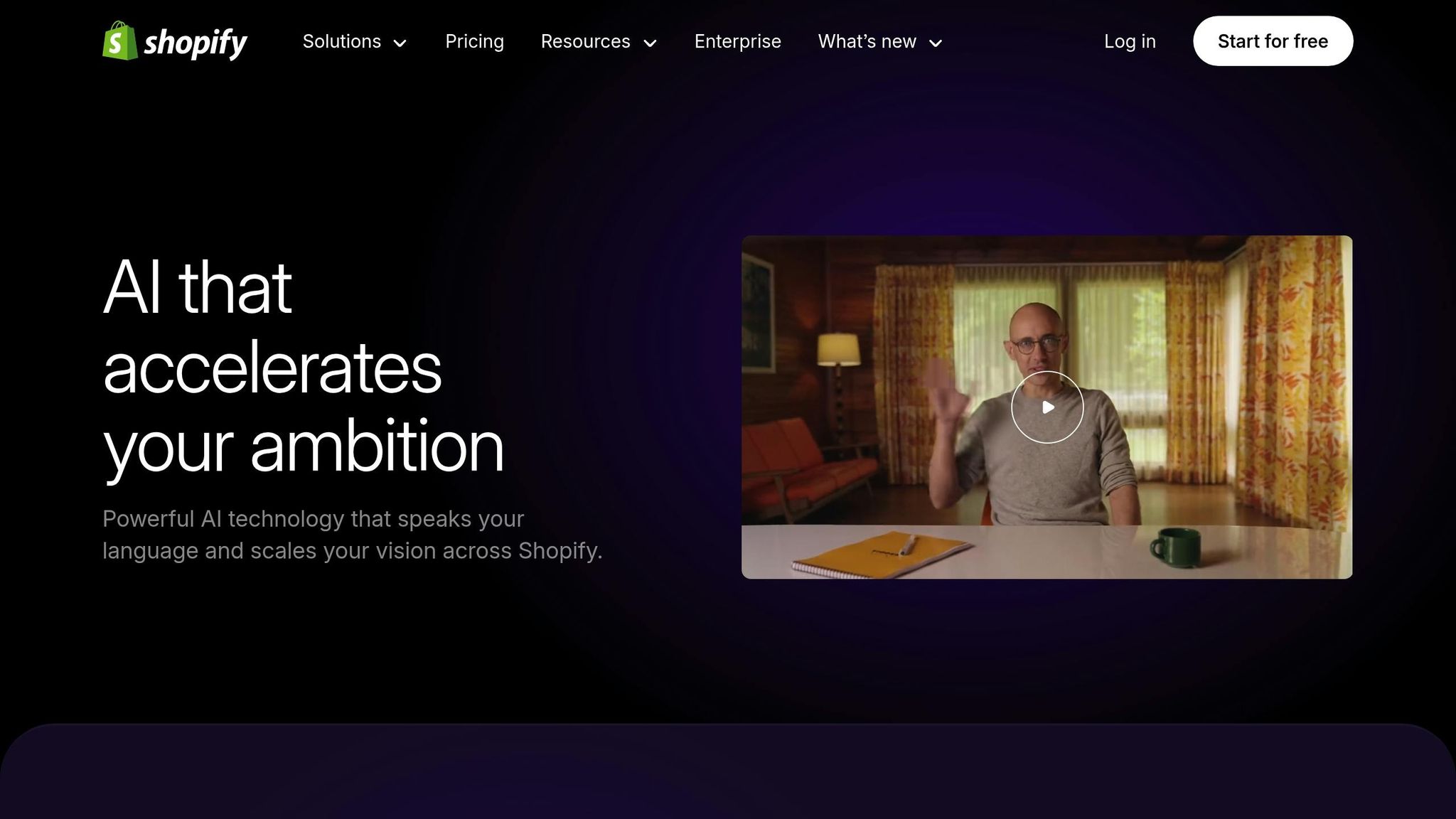
Shopify Magic brings AI into the heart of Shopify, simplifying e-commerce operations for merchants. This suite of AI-driven tools helps businesses tackle challenging tasks, make informed decisions, and compete with larger retailers - all without the hefty overhead. With 97% of small and medium-sized Shopify merchants planning to integrate AI into their operations by 2024, Shopify Magic is quickly becoming a must-have for staying ahead in the e-commerce game.
Key Features and Capabilities
Shopify Magic uses AI designed specifically for the needs of online retailers. It adapts to your brand's tone and style, ensuring that all content aligns seamlessly with your overall messaging.
One standout feature is Product Description Generation, which creates SEO-friendly descriptions by weaving in targeted keywords. This not only saves time but also improves search engine visibility. Other tools include Email Marketing Optimization, which crafts engaging subject lines and emails, and AI-Powered Customer Chat, which instantly responds to customer inquiries using your store's policies and past interactions as a guide.
The platform also offers predictive inventory insights to help merchants restock efficiently and personalizes shopping experiences to drive conversions. Additional features like content generation within the theme editor, instant customer service reply suggestions, and app review summaries further streamline operations. Together, these capabilities simplify everything from content creation to customer support.
Monetization Potential
AI adoption is proving to be a revenue booster. Businesses using AI have seen a 10–12% increase in revenue on average, while product recommendation engines can increase revenue by as much as 300% and improve conversion rates by 150% for online retailers. One independent apparel brand reported an 18% lift in conversions after using Shopify Magic.
The CEO of Glitch Anomaly, an apparel brand, shared their success with Shopify Magic:
"I use Shopify Magic to write product descriptions by inputting desirable keywords for SEO. It gives me the ability to work more efficiently and save costs… It's a game changer."
Customer service improvements also drive growth. In the U.S., 61% of consumers say chatbots save them time with their 24/7 availability, and 45% appreciate the instant responses they provide. As 80% of retail and e-commerce businesses either use or plan to use AI chatbots, Shopify Magic’s conversational AI ensures merchants remain competitive.
AI also optimizes supply chains, reducing excess inventory by up to 20% and cutting supply chain costs by 10%, all while meeting demand. Additionally, translation tools cater to global shoppers - 76% of whom prefer buying products with information in their native language. In fact, 40% of shoppers won’t purchase from sites in unfamiliar languages.
Pricing (in USD)
Shopify Magic is available at no additional cost to all Shopify merchants, regardless of their subscription plan. This includes features like product description generation, email content creation, customer chat, and inventory insights. While image generation may have future charges, all current features remain free for active merchants. This pricing approach makes advanced AI tools accessible to businesses of all sizes without extra fees or usage limits.
Industry Use Cases
Shopify Magic is proving its worth across various e-commerce sectors. In Fashion and Apparel, brands use the tool to craft SEO-rich product descriptions that reflect their unique style. Food and Beverage merchants, like those in the hot sauce market, benefit from storytelling features that enhance product appeal and boost conversions. Even service-based businesses, offering digital products or consultations, use Shopify Magic to create polished service descriptions and FAQs that maintain a consistent tone while engaging customers.
Drew Davis, the founder of Crippling Hot Sauce, shared his thoughts on the platform:
"Having had time to explore Shopify Magic, the product description generator has left me thoroughly impressed."
Next, learn how Synthesia is transforming video content creation for scalable marketing.
8. Synthesia
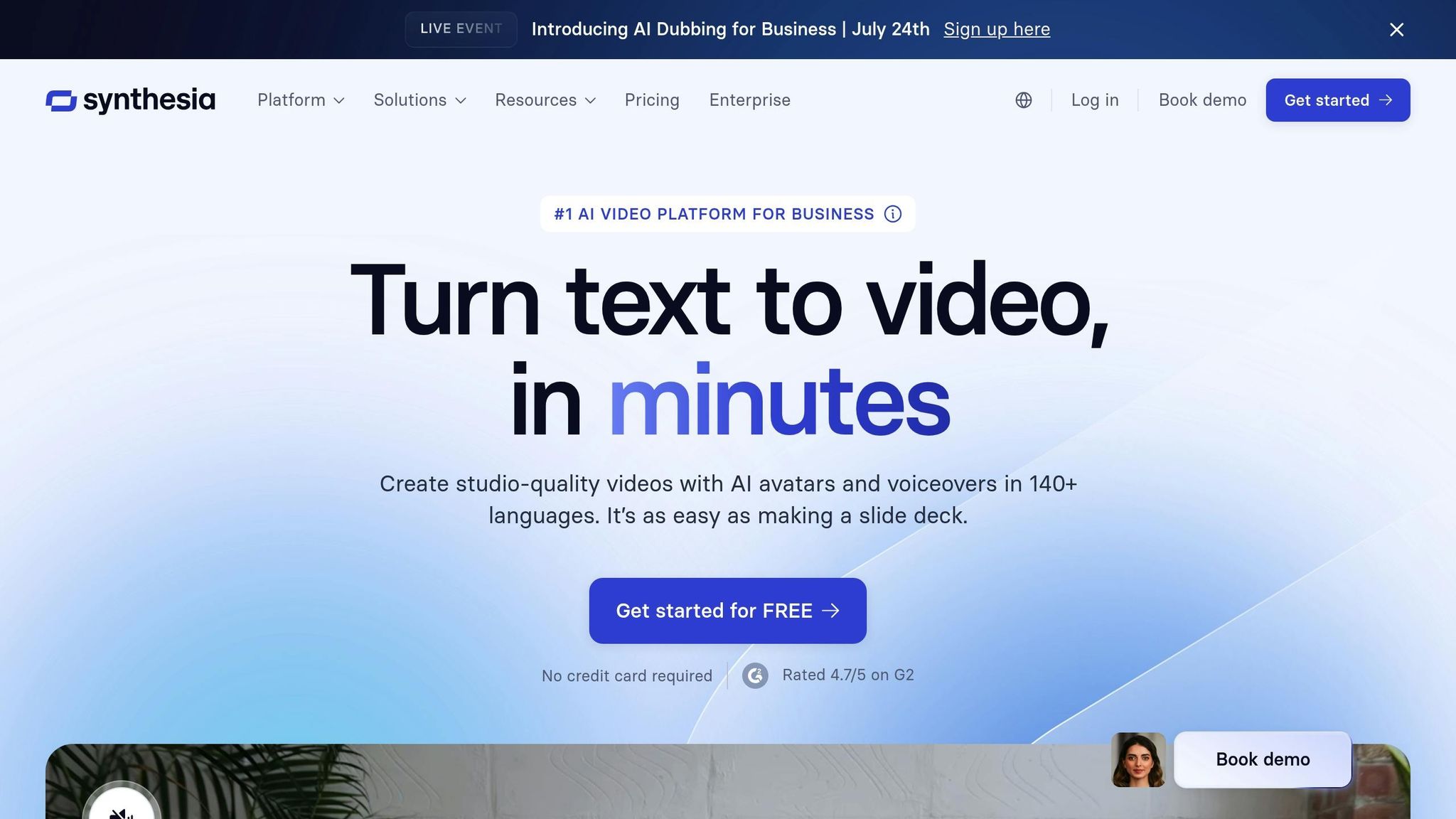
Synthesia is reshaping how businesses create video content by leveraging AI avatars to produce professional-quality videos - no cameras, studios, or actors required. Trusted by 70% of Fortune 100 companies and over 50,000 teams worldwide, it’s a go-to platform for organizations aiming to scale video production while keeping costs in check.
The platform transforms text into captivating videos featuring realistic AI avatars, eliminating the need for traditional production setups. With support for over 140 languages and AI dubbing available in 29 languages, Synthesia makes video creation accessible on a global scale.
Key Features and Capabilities
Synthesia offers a robust set of tools tailored for efficient video production. Users can choose from more than 230 customizable AI avatars and easily convert documents, PDFs, slides, and blog posts into polished videos. It even enables multi-avatar conversations, making it ideal for creating dynamic training materials.
The platform also includes advanced features like an AI video assistant, a screen recorder, a multilingual video player, real-time collaboration tools, and customizable templates. Its integrated media library ensures brand consistency while simplifying the content creation process.
Monetization Potential
Synthesia doesn’t just save time - it saves money. For instance, DuPont's Operational Excellence team slashed video production costs by $10,000 per training video, while Zoom’s instructional designers reduced video generation time by 90%. BSH also saw a 30% boost in engagement with e-learning content compared to traditional text-based formats.
Efficiency gains are a recurring theme. Production time that used to take hours can now be completed in minutes, and translation tasks have been condensed from 100 hours to just 10 minutes. AI-powered tools accelerate video creation by up to 80%, allowing businesses to expand their video marketing, training, and customer service efforts without proportional cost increases.
Industry Use Cases
Synthesia’s versatility makes it a valuable tool across industries. In Learning & Development, one designer noted that updating 10,000 courses is now manageable in-house. Sales teams have reported a 35% increase in meetings thanks to role-specific explainer videos, while customer support teams use Synthesia to transform dense help articles into engaging, user-friendly videos. The platform also excels in marketing, HR onboarding, and internal communications.
"Thanks to the role-specific product explainer videos made with Synthesia we booked 35% more meetings compared to previous trade shows."
"Using Synthesia, we effectively transformed dense help articles into user-friendly videos, significantly enhancing our customer support experience."
"Synthesia is solving 2 key problems for me: I can use the in-built AI to generate my script and then make an AI avatar speak it."
With its wide-ranging capabilities and proven results, Synthesia showcases how AI-driven tools, much like Zapier AI, can revolutionize workflows and boost revenue opportunities.
9. Zapier AI
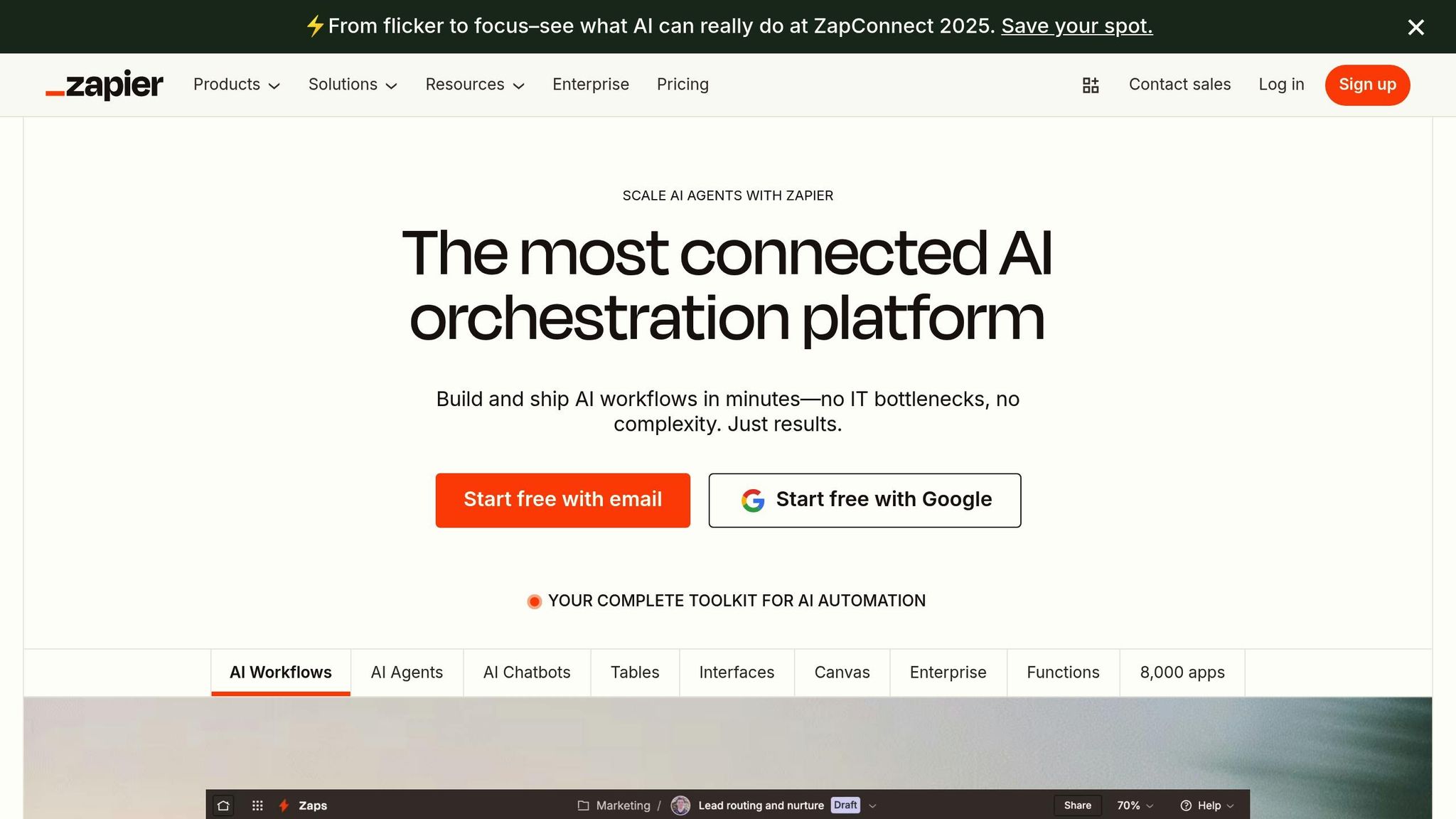
Zapier AI is a powerhouse for automating workflows, seamlessly blending AI with an extensive app ecosystem. Trusted by 3.4 million companies, it connects over 300 AI tools with nearly 8,000 everyday applications. Over time, it has evolved into a tool that not only automates but also learns and makes informed decisions to optimize business operations.
Each year, Zapier users automate billions of tasks, including more than 250 million AI-driven ones, showcasing its massive role in business automation.
Key Features and Capabilities
Zapier AI simplifies even the most complex workflows with intelligent automation. Its AI-powered Zap builder allows users to create automations using natural language prompts, while the AI Copilot offers on-the-spot guidance during workflow setup. Other standout tools include:
- Formatter: Cleans up data for better usability.
- AI by Zapier: Enables custom prompts tailored to specific needs.
- Zapier Agents: Acts as independent AI "teammates" to handle tasks autonomously.
Dynamic conditional logic ensures workflows adapt automatically, and AI-guided troubleshooting resolves issues efficiently. Additional features like Chatbots for customer interactions, Canvas with Interfaces and Tables for managing help desk flows, and Functions for custom JavaScript logic make it a versatile tool for tasks such as lead qualification and customer support.
Monetization Potential
Zapier AI delivers measurable financial benefits across businesses of all sizes. For example:
- Remote.com: A three-person IT team now automates 28% of company requests.
- Vendasta: Recovered $1 million in pipeline through automation.
- Arden Insurance Services: Saves approximately $500,000 annually in overhead.
- Contractor Appointments: Helped clients generate over $134 million in revenue through automation.
Smaller-scale success stories also highlight its value:
- Pretto: Saved $10,000 annually by automating feedback management.
- Laudable: Cut $240,000 in engineering costs.
- Learn It Live: Reduced support tickets by 40% using an AI chatbot.
Businesses using Zapier for marketing automation report a 53% increase in conversion rates and a 34% boost in revenue. Additionally, 90% of knowledge workers say automation has improved their jobs.
"With the help of automation, Contractor Appointments has been able to help our clients report over $134 million in revenue."
- Ben Leone, CTO, Contractor Appointments
By cutting overhead and increasing efficiency, Zapier AI directly impacts revenue growth, offering a compelling case for its adoption.
Pricing
Zapier AI offers flexible pricing with options to add specialized AI features.
Core Plans:
- Free: 100 tasks/month, 2-step Zaps, AI power-ups, unlimited Zaps.
- Professional: $29.99/month, includes unlimited premium apps, multi-step Zaps, webhooks, and email/chat support.
- Team: $103.50/month, supports up to 25 users with shared workspaces and SAML SSO.
- Enterprise: Custom pricing for unlimited users and advanced admin controls.
Additional AI Features:
- Zapier Agents: $50/month for 1,500 activities (Pro); 400 actions/month (Free).
- Zapier Chatbots: $20/month for 5 chatbots (Pro); $100/month for 20 chatbots (Advanced).
- Zapier Tables: $20/month for 20 tables (Pro); $100/month for 50 tables (Advanced).
- Zapier Interfaces: $20/month for 5 interfaces (Pro); $100/month for 20 interfaces (Advanced).
Industry Use Cases
Zapier AI's versatility makes it a go-to solution across industries. Marketing teams use it to create large-scale personalized email campaigns. Customer support departments rely on AI chatbots trained on internal resources to improve service quality. Sales teams benefit from automated lead qualification and follow-up sequences, while operations teams streamline tasks like invoice processing, inventory management, and onboarding.
Startups especially benefit from Zapier, as it allows them to scale quickly without increasing manual workloads.
"Zapier lets us spin up and test automations in hours, not full engineering sprints."
- Korey Marciniak, Senior Manager of Customer Support Strategy and Operations
10. Tableau AI
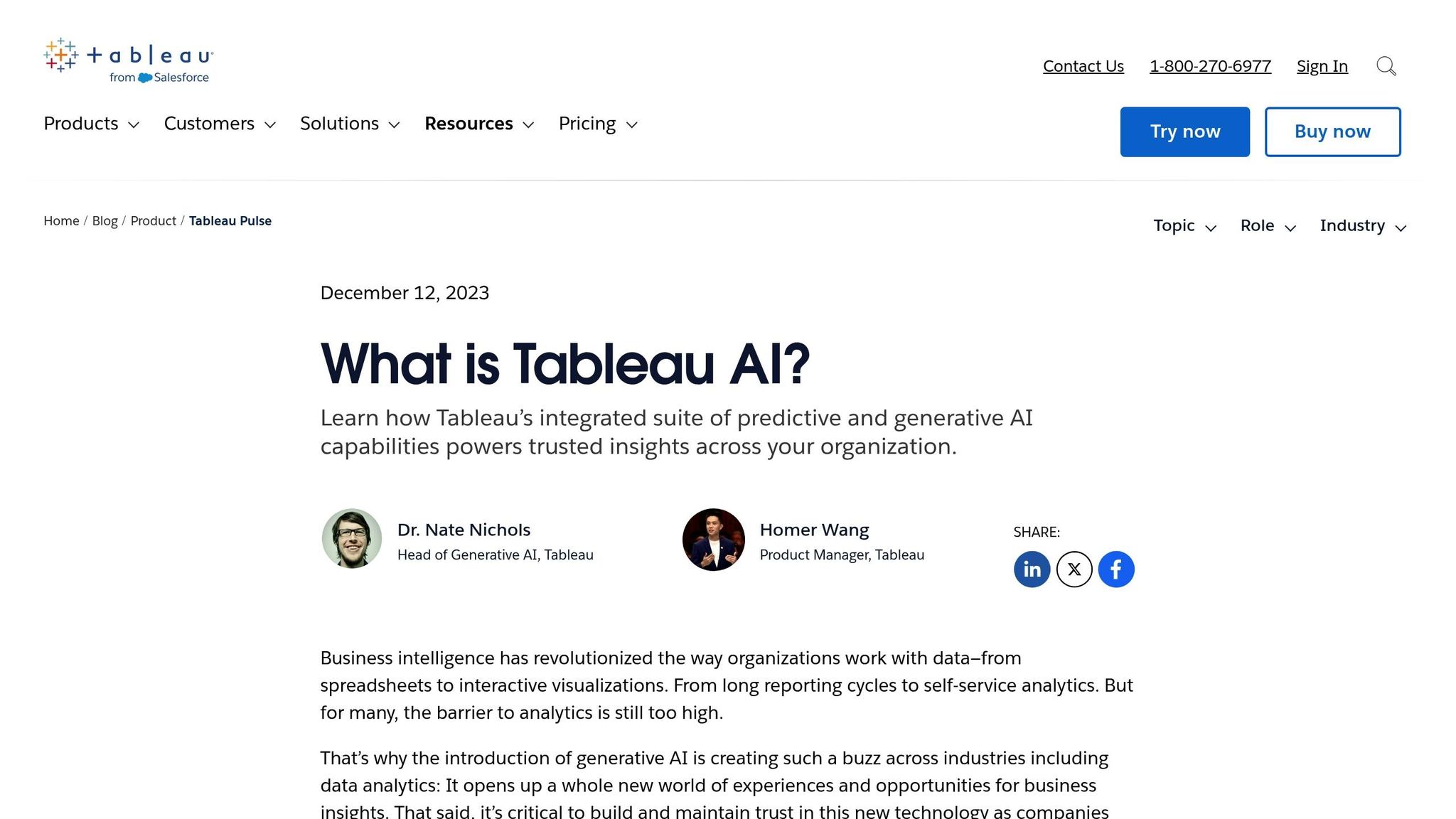
Tableau AI transforms data analysis into a user-friendly experience by embedding generative AI across its platform. It shifts the focus from static dashboards to dynamic, responsive systems that align with business needs, making data insights accessible to everyone in an organization.
Key Features and Capabilities
Tableau Agent acts as a virtual data analyst, enabling users to interact with data using natural language. Instead of manually creating formulas or visualizations, users can ask questions in plain English and instantly receive relevant charts, calculations, and insights. It integrates seamlessly with tools like Tableau Prep, Tableau Catalog, and Tableau Cloud Web Authoring, continuously improving its responses.
Tableau Next delivers analytics tailored to individual users. By leveraging Salesforce's Agentforce framework and pre-built analytics skills, it creates personalized experiences that go beyond traditional dashboards, adapting to user behavior.
Tableau Pulse brings critical insights directly into daily workflows. It monitors key metrics, prioritizes insights, and generates AI-driven narratives to explain trends. When metrics shift, Pulse sends alerts with contextual explanations to ensure timely action.
Concierge simplifies data access for non-technical users by providing natural language queries that return reliable answers paired with visual insights.
The platform's Semantic Learning feature enhances AI performance by learning from real-time Q&A sessions and managing business preferences in a centralized repository, ensuring more accurate and relevant insights over time.
These features collectively enable businesses to extract actionable insights quickly, streamlining complex processes into intuitive, impactful solutions.
Monetization Potential
Tableau AI delivers measurable financial benefits by enabling faster decision-making and improving operational efficiency. For example, in Q4 2024, the CFO of a Fortune 500 manufacturing company used Tableau Pulse to identify a supply chain issue in Germany two weeks ahead of schedule, avoiding a potential $4 million loss.
"It's like having a virtual analyst on call 24/7, surfacing problems and opportunities before we even think to ask." - CFO of a Fortune 500 manufacturing firm
In another instance, a regional bank implemented Tableau Agent in 2024, leading to a 40% increase in self-service analytics adoption and a reduction in report backlogs. Predictive capabilities have also proven valuable: a multinational manufacturing firm used Einstein Discovery within Tableau to predict stockouts. This enabled the COO to expedite orders and prevent a production line shutdown, saving approximately $500,000 per day. Additionally, optimized inventory levels reduced carrying costs by 10%.
The broader market for data monetization is growing rapidly. According to Deloitte's 2023 Global Technology Leadership Study, 36% of executives are already generating revenue through data-related services. The global data monetization market is expected to grow at a compound annual growth rate (CAGR) of 22.1% from 2021 to 2030. McKinsey research further highlights that high-performing companies are three times more likely to report that these efforts contribute over 20% to their total revenue.
With its proven financial impact, Tableau AI is offered through competitive pricing models.
Pricing
Tableau AI is included in the Tableau+ bundle, with pricing available through direct sales. Tableau Cloud pricing options include:
- Creator: $75 per user/month (billed annually)
- Explorer: $42 per user/month (billed annually)
- Viewer: $15 per user/month (billed annually)
For on-premises solutions, Tableau Server offers customized pricing based on infrastructure and business needs.
Industry Use Cases
Tableau AI's practical applications span multiple industries:
- Retail and E-commerce: Businesses use Tableau AI for real-time customer behavior analysis and inventory management. For instance, Ocado Retail integrated Tableau analytics into its Ocado Retail Data Platform, providing over 400 FMCG suppliers with real-time insights. Suppliers using this platform have seen revenue grow 4% faster than competitors.
- Sports Organizations: Raw Stadia leverages embedded analytics to help sports teams enhance athlete performance and reduce injury risks, creating new revenue opportunities through data insights.
- Financial Services: Firms utilize predictive analytics for risk management and customer insights. Automated alerts help prevent costly disruptions and identify new opportunities through pattern recognition.
- Manufacturing: Companies rely on Tableau AI for optimizing supply chains, predictive maintenance, and quality control. By proactively surfacing insights, the platform helps avoid downtime and ensures efficient resource allocation across operations.
These examples showcase how Tableau AI is driving meaningful improvements across diverse sectors.
Tool Comparison Chart
Selecting the right AI tool can have a big impact on your revenue. Here's a breakdown of key monetization methods, standout features, pricing details, and potential drawbacks for each platform.
| Tool | Primary Monetization | Key Features | Pricing (USD) | Main Limitations |
|---|---|---|---|---|
| AI Apps | Content creation, business planning, data analysis | Comprehensive tool directory, diverse applications | Varies by app | General-purpose; lacks specialized features |
| ChatGPT Enterprise | Business consulting, content strategies, automation | Advanced AI capabilities, business planning, data analysis | Custom enterprise pricing | May produce inaccurate results; needs oversight |
| Jasper AI | High-volume content production, marketing campaigns | Content templates, internet research, AI image generation | Tiered plans available | Best for high-volume users; learning curve for beginners |
| Copy.ai | Translation services, marketing copy | AI and human translation, content generation | Varies by plan | Limited creative control; editing often required |
| MidJourney | Digital art sales, visual content creation | Painterly aesthetic, image-to-video generation | $10/month (basic plan) | Style limitations; subscription required |
| Runway ML | Video production services, creative content | AI video generation, model training, frame editing | Usage-based plans | Steep learning curve; slower processing times |
| Shopify Magic | E-commerce automation, online store optimization | Product descriptions, customer service, ad targeting | Included with Shopify plans | Requires Shopify store; ecosystem-specific |
| Synthesia | Video marketing, training content creation | Realistic AI avatars, studio-free production | $29/month (starter plan) | Limited avatar options; scripted content feel |
| Zapier AI | Automation services, custom chatbot development | Custom AI chatbots, workflow automation | Usage-based plans | Complexity increases with advanced workflows |
| Tableau AI | Data consulting, business intelligence services | Pattern recognition, data science, predictive analytics | Varies by license | Requires data expertise; steep learning curve |
This table provides a quick overview of each tool's strengths and challenges, helping you weigh technical capabilities against potential revenue outcomes.
The AI market is expected to hit $244.22 billion by 2025, growing at a 26.60% annual rate. A significant 91% of AI users rely on general-purpose tools for most tasks, with these platforms accounting for 81% of the $12 billion consumer AI spend in the U.S. today.
When evaluating tools, consider the total cost of ownership. Development costs alone can take up 40–60% of a project’s budget, with maintenance adding another 15–25%. However, organizations often see a 30–40% reduction in operational costs and a 25% productivity boost within 18–24 months of using AI effectively.
Accuracy and reliability remain the biggest hurdles for all platforms. As Wharton professor Lynn Wu explains:
"One good rule of thumb is that if you're already good at [something], AI is going to help even more. But if you're not good already or have very rudimentary knowledge, I would use AI cautiously because it does hallucinate."
For freelancers and small businesses, affordable tools like MidJourney and Synthesia (starting at $10–29/month) offer low-cost entry points. Larger enterprises should explore Tableau AI or ChatGPT Enterprise for scalable solutions, though these come with higher upfront costs and require more expertise.
Interestingly, creative professionals show a strong willingness to pay for niche tools, while general-purpose platforms dominate daily tasks. This highlights the value of a mixed approach: use cost-effective general tools for routine work and invest in specialized platforms for high-stakes projects.
Conclusion
The AI revolution is in full swing, and 2025 offers incredible opportunities to generate income using AI tools. With rapid market growth and widespread adoption by companies worldwide, there's no better time to dive in.
The tools highlighted in this guide provide a variety of ways to earn. Whether you're a freelancer enhancing productivity with MidJourney's creative features, a business owner streamlining operations through Shopify Magic, or part of a larger enterprise leveraging ChatGPT Enterprise for scalable solutions, there's an AI tool tailored to your needs and budget. These tools have already delivered measurable results, as seen in the success stories shared here.
For instance, companies using generative AI report average performance improvements of 66% and revenue increases exceeding 5% in areas like supply chain and inventory management.
Achieving success with AI tools, however, requires a thoughtful strategy. Focus on platforms that save time, sharpen your skills, reduce expenses, and unlock new opportunities. Start by identifying challenges in your industry where AI can make an immediate difference, and experiment with tools that address those specific needs.
The competitive landscape is evolving quickly, and businesses incorporating AI into their operations are gaining a lasting edge.
It's important to remember that AI enhances human expertise rather than replacing it. The opportunities in 2025 are immense, but they won't stay open forever. By choosing tools like MidJourney, Shopify Magic, and ChatGPT Enterprise, you can amplify your skills and revenue potential. The question isn't whether AI will transform how we earn - it's whether you'll be ready to seize the moment and make the most of this revolution.
FAQs
How can small businesses use AI tools like Shopify Magic to boost revenue in 2025?
Small businesses have a powerful ally in AI tools like Shopify Magic, which can help streamline daily operations and boost revenue in 2025. By automating tasks like customer service, inventory tracking, and personalized marketing, these tools free up valuable time, cut costs, and enhance the overall shopping experience.
Take personalized marketing, for instance. AI can analyze customer behavior to suggest products tailored to individual preferences, increasing the chances of a sale. It can also predict demand trends, helping businesses keep popular items in stock and avoid overstocking. With these capabilities, small businesses can compete more effectively and tap into greater revenue opportunities in an AI-driven marketplace.
What should I consider when choosing between AI tools like Jasper AI and MidJourney for content creation?
When deciding between tools like Jasper AI and MidJourney, it’s crucial to match their strengths to your specific needs. Jasper AI is ideal for generating high-quality text-based content, such as blog posts, articles, and marketing copy. On the other hand, MidJourney specializes in creating eye-catching, AI-generated visuals.
You’ll also want to weigh factors like ease of use, how well the tool integrates with your current workflow, and pricing. Don’t overlook the uniqueness of the outputs and any concerns about the ethics of AI-generated content. Your ultimate decision should hinge on your goals and the type of content you aim to create.
How do AI tools like ChatGPT Enterprise and Zapier AI help businesses increase productivity and profits?
AI tools such as ChatGPT Enterprise and Zapier AI are transforming the way businesses operate by automating routine tasks, simplifying workflows, and saving valuable time. For instance, ChatGPT Enterprise can cut down research time by as much as an hour each day, giving teams the freedom to dedicate more energy to strategic and impactful work. Similarly, Zapier AI seamlessly integrates automation into business processes, helping to simplify operations and reduce expenses.
By incorporating these tools, companies can enhance efficiency, make smarter decisions, and deliver better outcomes while using fewer resources. This makes them essential for maintaining a competitive edge as we move into 2025 and beyond.



